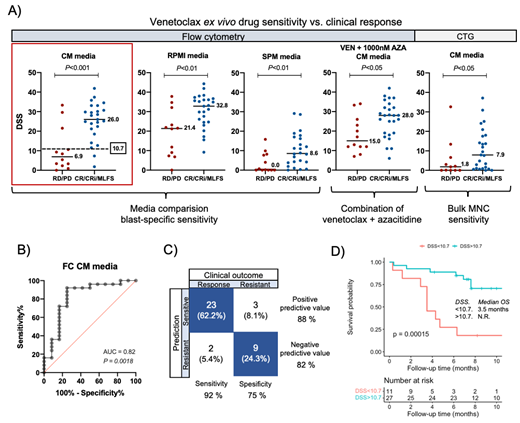Abstract
Background
BCL-2 inhibitor venetoclax (Ven) in combination with azacitidine (Aza) has substantially improved overall response rates (ORR) and overall survival (OS) in newly diagnosed nonfit acute myeloid leukemia (AML). Nevertheless, 1/3 of patients (pts) do not respond to the treatment, and for relapsed/refractory (R/R) pts the ORR is 20‒50%. While certain genetic changes correlate with treatment outcome (e.g., IDH2, TP53), mutations do not precisely predict Ven-Aza response. Thus, novel approaches are needed to identify those who benefit from Ven-Aza, particularly in the R/R setting.
Ex vivo drug sensitivity has been explored in small pilot studies to guide treatment in R/R AML. However, very few prospective clinical trials have analyzed the predictability of ex vivo drug sensitivity testing. It is also unknown whether different drug testing platforms (e.g., flow cytometry (FC) and luminescent cell viability assays) and culture conditions influence the predictive accuracy. Therefore, we designed a prospective trial to evaluate the ex vivo/in vivo correlation of drug sensitivity testing with the Ven-Aza treatment outcome in AML.
Methods
VenEx is an ongoing, multicenter, open-label phase II study by the Finnish AML Group (NCT04267081) that includes nonfit de novo, R/R, and secondary AML (sAML) pts. Here, we report the interim results from the first part of the trial (validation cohort), in which all patients received study treatment regardless of the ex vivo drug sensitivity testing results (n = 39). All pts received Aza (75 mg/m 2 on days 1‒7, 28-day cycle) and Ven (400 mg once daily, 28-day cycles, shortened in responding pts to 21 days). The primary endpoint was cumulative ORR (CR/CRi/MLFS) during the first three treatment cycles, and a key secondary endpoint was the correlation of ex vivo drug sensitivity with ORR and OS.
For drug sensitivity testing, 20 ml of bone marrow (BM) was shipped to the central laboratory, and Ficoll-purified mononuclear cells (MNCs) were plated within 26 hours after sampling. The drug plates contained Ven, Ven + Aza, and other BCL-2 family inhibitors across a 10,000-fold concentration range. Ven sensitivity was measured in three cell culture conditions: 1. RPMI, 2. conditioned medium (CM, HS-5 cell line derived medium (Karjalainen et al., 2017), and 3. StemSpan SFEMII + 20 ng/ml of FLT3L + SCF + TPO (SPM). After 48 h of incubation with the drugs, cell viability was measured in parallel with CellTiter-Glo (CTG) and FC, as described by Kuusanmäki et al. (2020). Drug sensitivity score (DSS) derived from the area under the dose response curve calculations indicated efficacy (Yadav et al., 2014).
Results
In the validation cohort, 16 pts had de novo AML and 23 had sAML or R/R AML. The ORR for de novo AML was 88% (14/16) and for R/R or sAML 52% (12/23). Drug sensitivity testing was successful in 38/39 pts.
The best correlation of responding and non-responding pts occurred when blast-specific Ven sensitivity was measured by FC in CM media (p < 0.001, Figures A-B). When the ex vivo/in vivo correlation with CTG (BM bulk MNC sensitivity) was assessed, several pts who had achieved CR/CRi/MLFS during the first three cycles were resistant to Ven ex vivo (Figure A). Similarly, the SPM medium yielded false negative ex vivo responses in blast-specific FC measurement. Ex vivo testing of the Ven-Aza combination by FC did not increase the predictive accuracy over Ven alone (Figure A).
Using a DSS threshold of 10.7 for blast-specific FC Ven sensitivity in CM, the test's sensitivity was 92%, its specificity was 75%, and its positive predictive value was 88% (Figure C). The median OS for patients who had DSS < 10.7 (ex vivo resistant) was 3.5 months, and those with DSS > 10.7 (ex vivo sensitive) have not reached the median OS (p < 0.001, Figure D).
Conclusions
Ex vivo drug sensitivity testing was feasible for AML pts in a clinical trial context. Leukemic blast-specific ex vivo Ven sensitivity showed a high correlation with ORR, with a positive predictive value of 88%, and predicted longer OS. The interim results argue that ex vivo Ven sensitivity can be used as a predictive biomarker for Ven-Aza therapy. Notably, experimental conditions had considerable influence on the predictive value of ex vivo Ven sensitivity; thus, between-trial standardization is crucial. The ongoing VenEx trial will validate these findings in the second part of the trial (60 pts) where ex vivo Ven sensitivity guides therapy in pts with R/R or sAML.
Kuusanmäki: AbbVie: Research Funding. Heckman: Novartis: Research Funding; Orion Pharma: Research Funding; Celgene/BMS: Research Funding; Oncopeptides: Consultancy, Research Funding; Kronos Bio, Inc.: Research Funding. Ettala: Novartis: Membership on an entity's Board of Directors or advisory committees; Pfizer: Membership on an entity's Board of Directors or advisory committees; Amgen: Other: Conference expensens; Sanofi: Other: Conference expensens. Pyörälä: Pfizer: Honoraria; Novartis: Honoraria; AbbVie: Honoraria. Rimpiläinen: Astellas: Membership on an entity's Board of Directors or advisory committees; AbbVie: Membership on an entity's Board of Directors or advisory committees; Pfizer: Membership on an entity's Board of Directors or advisory committees. Siitonen: amgen: Honoraria; Novartis: Honoraria, Membership on an entity's Board of Directors or advisory committees; Brystol Myers Squibb: Consultancy; Janssen-Cilag: Consultancy, Membership on an entity's Board of Directors or advisory committees; abbvie: Membership on an entity's Board of Directors or advisory committees; Pfizer: Consultancy, Membership on an entity's Board of Directors or advisory committees; celgene: Membership on an entity's Board of Directors or advisory committees. Kontro: Astellas: Consultancy, Membership on an entity's Board of Directors or advisory committees; Jazz Pharmaceuticals: Membership on an entity's Board of Directors or advisory committees; AbbVie: Membership on an entity's Board of Directors or advisory committees, Research Funding.


This feature is available to Subscribers Only
Sign In or Create an Account Close Modal